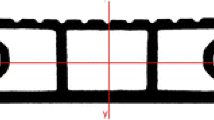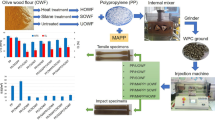Abstract
To take advantage of the unique characteristics of the wood flour by combining them with plastic in conventional panel pressing methods, a wet process was developed to make composites using polypropylene and steam-exploded (SE) flour from small-diameter loblolly pine. Wet-laid wood flour/polymer composites were fabricated using a standard TAPPI handsheet method followed by compression molding. The variables that may affect the product properties were investigated using an orthogonal test design. The results revealed that the modulus of elasticity (MOE) of composites increased, while modulus of rupture (MOR) decreased with increasing SE wood flour content. Both MOE and MOR of the composites increased with maleic anhydride grafted polypropylene content. Dynamic mechanical analyzer and differential scanning calorimetry measurement gave insight into the structure of these composites, and scanning electron microscope was used to characterize the interfacial adhesion.
Zusammenfassung
Um die besonderen Eigenschaften von Holzmehl in Kombination mit Kunststoff bei konventionellen Plattenpressverfahren voll auszunutzen, wurde ein Nassverfahren zur Herstellung von Verbundwerkstoffen aus Polypropylen und im Dampfdruckverfahren erzeugtem Holzmehl aus Weihrauchkieferschwachholz entwickelt. Holzmehl-Polypropylen-Verbundstoffe wurden nach einem TAPPI-Standardverfahren im Nassverfahren aufgebracht und anschließend verpresst. Die Variablen, die die Produkteigenschaften beeinflussen können, wurden mittels eines orthogonalen Versuchsdesigns untersucht. Die Ergebnisse zeigten, dass der E-Modul der Verbundwerkstoffe mit zunehmendem Holzmehlanteil zunahm, während die Biegefestigkeit abnahm. Mit steigendem Gehalt an Maleinsäureanhydrid gepfropftem Polypropylen stieg sowohl der E-Modul als auch die Biegefestigkeit der Werkstoffe. Dynamisch-mechanische Analysen und Differenzialrasterkalorimeter-Messungen gaben einen Einblick in die Struktur dieser Verbundwerkstoffe. Mittels eines Rasterelektronenmikroskops wurde die Haftung zwischen dem Holz und der Kunststoffmatrix untersucht.
Similar content being viewed by others
References
Angles MN, Salvado J, Dufresne A (1999) Steam-Exploded Residual Softwood-Filled Polypropylene Composites. J Appl Polym Sci 74:1962–1977
ASTM (2003) Standard test method for flexural properties of unreinforced and reinforced plastics and electrical insulating materials: ASTM D790-03. American Society for Testing and Materials, West Conshohocken, PA, USA
Cheng Q, Wang J, Shaler SM (2009) Mechanical performances of wood plastic composites due to extended water immersion. J Thermoplast Compos Mater 22:321–333
Cheng Q, Wang S, Rials TG, Lee SH (2007) Physical and mechanical properties of polyvinyl alcohol and polypropylene composite materials reinforced with fibril aggregates isolated from regenerated cellulose fiber. Cellulose 14(6):593–602
Clemons CM, Caufield DF (2005) Wood flour, in Functional fillers for plastics. Wiley-VCH, Weinheim, pp 249–270
English BW, Falk RH (1995) Factors that affect the application of wood fiber-plastic composites. In: Proc of Woodfiber-plastic composites: Virgin and recycled wood fiber and polymers for composites, May 1–3, 1995, Madison, WI, pp 189–194
Harper D, Wolcott M (2004) Interaction between coupling agent and lubricants in wood-polypropylene composites. Compos Part A Appl Sci Manuf 35:385–394
Michaud F, Riedl B, Castera P (2005) Improving wood/polypropylene fiberboards properties with an original MAPP coating process. Holz Roh- Werkst 63(5):380–387
Oksman K, Clemons C (1998) Mechanical properties and morphology of impact modified polypropylene-wood flour composites. J Appl Polym Sci 67:1503–1513
Okamoto T, Takashi M, Kitayama T, Kato O, Ito H, Miwa K (1999) Designing natural fiber for advanced materials. In: Proc of The 5th International Conference on Woodfiber-Plastic Composites, May 26–27, 1999, Madison, WI, pp 57–66
Snijder MHB, Bos HL (1999) Reinforcement of commodity plastics by annual plant fibers: optimization of the coupling agent efficiency. In: Proc of The 5th International Conference on Woodfiber-Plastic Composites, May 26–27, 1999, Madison, WI, pp 123–129
Stark NM, Berger MJ (1997) Effect of particle size on properties of wood-flour reinforced polypropylene composites. In: Proc of The 4th International Conference on Woodfiber-Plastic Composites, May 12–14, 1997, Madison, WI, pp 134–143
Takatani M, Ito H, Ohsugi S, Kitayama T, Saegusa M, Kawai S, Okamoto T (2000) Effect of lignocellulosic material on the properties of thermoplastic polymer/wood composite. Holzforschung 54(2):197–200
Wang S, Winistorfer PM (2000) Fundamentals of vertical density profile formation in wood composites part II, Methodology of vertical density formation under dynamic conditions. Wood Fiber Sci 32(2):220–238
Wu Y, Li Y, Hu Q (eds) (1995) Applied Mathematical Statistics. National University of Defense Technology Press, Hefei
Yin S, Wang S, Rials TG, Kit K, Hansen M (2007) Polypropylene composites filled with steam-exploded wood flour from insect-killed loblolly pine by compression-molding. Wood Fiber Sci 39(1):95–108
Yin S, Rials TG, Wolcott MP (1999) Crystallization behavior of polypropylene and it effect on woodfiber composite properties. In: Proc of The 5th International Conference on Woodfiber-Plastic Composites, May 26–27, 1999, Madison, WI, pp 139–146
Author information
Authors and Affiliations
Corresponding author
Rights and permissions
About this article
Cite this article
Cheng, Q., Wang, S., Rials, T.G. et al. Fabrication optimization of polypropylene composites reinforced with steam-exploded wood flour by wet process . Eur. J. Wood Prod. 67, 449–455 (2009). https://doi.org/10.1007/s00107-009-0339-8
Received:
Published:
Issue Date:
DOI: https://doi.org/10.1007/s00107-009-0339-8




